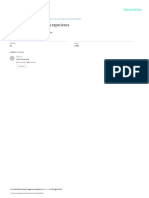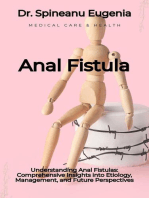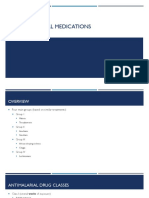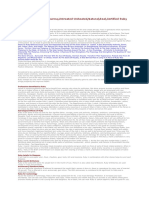Cureus 0013 00000015301
Cureus 0013 00000015301
Uploaded by
Abdunur MusemakweliCopyright:
Available Formats
Cureus 0013 00000015301
Cureus 0013 00000015301
Uploaded by
Abdunur MusemakweliOriginal Description:
Original Title
Copyright
Available Formats
Share this document
Did you find this document useful?
Is this content inappropriate?
Copyright:
Available Formats
Cureus 0013 00000015301
Cureus 0013 00000015301
Uploaded by
Abdunur MusemakweliCopyright:
Available Formats
Open Access Original
Article DOI: 10.7759/cureus.15301
Causes of Acute Peritonitis and Its Complication
Danesh Kumar 1 , Ishan Garg 2 , Atif Hussain Sarwar 3 , Love Kumar 1 , Vikash Kumar 4 , Sonam Ramrakhia 5, 6
, Sidra Naz 7 , Amna Jamil 8 , Zoya Qamar Iqbal 4 , Besham Kumar 9
1. Internal Medicine, Liaquat University of Medical and Health Sciences, Jamshoro, PAK 2. Clinical Medicine, Ross
University School of Medicine, Bridgetown, BRB 3. Internal Medicine, Ghulam Muhammad Mahar Medical College,
Sukkur, PAK 4. Internal Medicine, Jinnah Sindh Medical University, Karachi, PAK 5. Medicine, Liaquat University of
Medical and Health Sciences, Jamshoro, PAK 6. Medicine, Mustafai Trust Central Hospital, Sukkur, PAK 7. Internal
Medicine, University of Health Sciences, Lahore, PAK 8. Obstetrics and Gynecology, Jinnah Postgraduate Medical
Centre, Karachi, PAK 9. Internal Medicine, Jinnah Postgraduate Medical Centre, Karachi, PAK
Corresponding author: Amna Jamil, amnajamil.aj10@yahoo.com
Abstract
Introduction
Peritonitis is a significant cause of morbidity and mortality in surgical settings. Coexisting premorbid illness
and postoperative complications were found to be associated with death. This study aimed to analyze
various etiologies that cause peritonitis and shed light on the factors responsible for unsatisfactory results.
Method
This longitudinal study included 309 patients above 12 years of age, of either gender, with confirmed
diagnosis of peritonitis. Exploratory laparotomy was done to identify the cause of peritonitis. Patients were
monitored postoperatively till their discharge or death for the development of complications.
Results
Our results showed that the most common cause of acute peritonitis was duodenal perforation (26.2%),
followed by typhoid ileal perforation (24.2%) and ruptured appendix (16.8%). At least one complication was
observed in 31% of the participants. The most common complication was dehydration (18.8%), followed by
septicemia (11.3%) and paralytic ileus (6.4%). Ten (3.2%) patients died in the hospital.
Conclusions
Acute peritonitis is a serious surgical emergency caused by a number of diseases. Early surgical treatment
along with antibiotics, followed by aggressive resuscitation can yield improved outcomes in patients with
peritonitis.
Categories: Gastroenterology
Review began 05/16/2021
Keywords: peritonitis, etiology, complications, typhoid ileal perforation, ruptured appendix
Review ended 05/23/2021
Published 05/28/2021
© Copyright 2021 Introduction
Kumar et al. This is an open access article
Peritonitis, an inflammation of the peritoneum, is a life-threatening acute surgical emergency. It presents
distributed under the terms of the
Creative Commons Attribution License with severe abdominal pain and is a significant cause of morbidity and mortality ranging from 10%-60% in
CC-BY 4.0., which permits unrestricted surgical settings [1]. Existing literature shows that etiologies of peritonitis vary by geographic locations and
use, distribution, and reproduction in any local environmental factors with genetic predisposition. Appendicitis and typhoid ileal perforation are the
medium, provided the original author and
common causes of peritonitis with an estimated prevalence of about 43.1% and 35.1%, respectively [2-3].
source are credited.
Other causes of peritonitis include gastroduodenal perforations, intestinal volvulus, ruptured abscesses,
traumatic bowel perforation, perforated peptic ulcers, primary/idiopathic peritonitis, tubo-ovarian
abscesses, and amoebic colonic perforations. Knowledge of several distinct causes and presentation of
peritonitis in a particular setting will lead to improved local care and better overall understanding of the
disease process, as cause is directly related to prognosis [2-3].
Aggressive fluid resuscitation and early surgical intervention are the mainstay of therapy of peritonitis.
Enterocutaneous fistulas, surgical site infection, sepsis, and multiorgan failure are the commonest
complications seen in surgical settings. Others include abdominal compartment syndrome, wound
dehiscence, and respiratory insufficiency. Complications are influenced by advanced age and comorbidities.
Coexisting premorbid illness and postoperative complications were found to be associated with death [4,5].
Despite the rapid advancement in surgical techniques, modified antimicrobial therapies, and intensive care
support, the management of peritonitis continues to be more demanding, challenging, and complex than
ever [4].
Severely ill patients usually present in the late stage of the disease. Consequently, there is less time for
How to cite this article
Kumar D, Garg I, Sarwar A, et al. (May 28, 2021) Causes of Acute Peritonitis and Its Complication. Cureus 13(5): e15301. DOI
10.7759/cureus.15301
diagnostic approaches and proper decision-making for a strong treatment method. Lack of awareness, late
presentation, and its correlation with morbidity and mortality demonstrate that there is room for
betterment in medical treatment by a thorough examination of the etiologies, presentation, and results.
Prior studies primarily focused on single etiologies; therefore, they have not focused on interconnected
etiologies. The present study aimed to analyze various etiologies of peritonitis and shed light on the factors
responsible for unsatisfactory results.
Materials And Methods
This longitudinal study was conducted in the emergency unit of a tertiary care hospital in Pakistan from
January 2019 to March 2021. Patients with a confirmed diagnosis of peritonitis above 12 years of age and of
either gender, which included 309 patients, were included in the study. Patient were enrolled via
consecutive convenient non-probability technique. Their informed consent was taken. Ethical review board
approval was taken before start of patient enrollment. Diagnosis of peritonitis was made based on clinical
and radiological findings. Clinical findings included abdominal pain, vomiting, constipation, generalized
abdominal tenderness, and absent bowel sounds. Peritonitis was indicated by X-ray showed air under the
diaphragm.
Exploratory laparotomy was done to identify the cause of peritonitis. Operative findings like duodenal
perforation, ileal perforation, ileal stricture with perforation, and ruptured appendix were noted in a self-
structured questionnaire. Surgical intervention was done when required and the cause of perforation was
treated. Patients were monitored postoperatively for the development of complications. Complications such
as organ failure, septicemia, peritoneal abscess, paralytic ileus, burst abdomen, and surgical site infection
were recorded. Complications due to ileostomy or any other surgical intervention were not taken into
consideration in this study. Statistical Package of Social Sciences (SPSS) for Windows, version 22.0 (IBM
Corp., Armonk, NY) was used to analyze data. Frequencies and percentages were calculated for categorical
variables.
Results
Acute peritonitis was more common in males (65.0%) and in the age group from 21 to 40 years (Table 1).
Demographics Frequency (percentage)
Gender
Male 201 (65.0%)
Female 108 (35.0%)
Age group in years
12–20 77 (24.9%)
21–40 97 (31.3%)
41–60 79 (25.5%)
60+ 56 (18.1%)
TABLE 1: Demographics of the participants enrolled.
The most common cause of acute peritonitis was duodenal perforation (26.2%), followed by typhoid ileal
perforation (24.2%) and ruptured appendix (16.8%) (Table 2).
2021 Kumar et al. Cureus 13(5): e15301. DOI 10.7759/cureus.15301 2 of 5
Causes Frequency (percentage)
Duodenal perforation 81 (26.2%)
Typhoid ileal perforation 75 (24.2%)
Ruptured appendix 52 (16.8%)
Tuberculosis perforation 31 (10.0%)
Tumor perforation 21 (6.7%)
Liver cirrhosis 19 (6.1%)
Gangrenous gut 15 (4.8%)
Acute pancreatitis 06 (1.9)%
Acute diverticulitis 05 (1.6%)
Pelvic inflammatory disease 04 (1.2%)
TABLE 2: Causes of acute peritonitis.
At least one complication was observed in 97 (31.3%) participants. The most common complication was
dehydration (18.8%), followed by septicemia (11.3%), and paralytic ileus (6.4%). Ten (3.2%) patients died in
the hospital (Table 3).
Complications Frequency (percentages)
No complications 212 (68.6%)
Dehydration 57 (18.4%)
Septicemia & organ failure 35 (11.3%)
Paralytic ileus 20 (6.4%)
Burst abdomen 19 (6.14%)
Surgical site infection 15 (4.8%)
Enterocutaneous fistulas 11 (3.5%)
Hepatorenal syndrome 01 (0.3%)
Hepatic encephalopathy 01 (0.3%)
TABLE 3: Complications of acute peritonitis.
Discussion
The present study demonstrated peritonitis was significantly more prevalent in males, with a peak age group
of 21-40 years. Among the factors causing peritonitis, duodenal perforation was the most common, followed
by typhoid ileal perforation and ruptured appendix. Postoperative morbidity rate was 31.3% with
dehydration being the most common complication, followed by septicemia and paralytic ileus. The mortality
rate was 10%.
The findings of the present study are also supported by a study conducted by Choua et al. [6], who found that
males were at a higher risk of developing peritonitis, and the average age of the participants was 25.8 years.
The most common cause according to their study was visceral perforation, followed by diffuse appendiceal
peritonitis. Participants in the present study also had duodenal perforations and affected appendix as the
primary cause [6]. However, the morbidity and mortality rates in their study were lower than those of the
present study. Another study carried out by Hagos et al. also showed similar results [7]. Males were seen to
develop peritonitis more frequently. Acute appendicitis and perforated peptic ulcer disease were among the
common causes; problems with appendix and visceral perforations were also observed in the present study.
2021 Kumar et al. Cureus 13(5): e15301. DOI 10.7759/cureus.15301 3 of 5
The morbidity rate was 30.8% in their study, with wound infections and sepsis being common complications,
which was also observed in the present study. However, the mortality rate in the present study was 10%.
Mortality rates in some other studies were 11.8% [8] and 12.63% [9]. The possible explanation for this
variation in mortality rate is early diagnosis and presentation accompanied with effective surgical
treatment.
Helicobacter pylori is the main causative agent of acute peritonitis secondary to duodenal perforation [10]. It
is more common in developing countries where people do not have access to mineral water. However,
boiling tap water would prevent peritonitis, and physicians are advised to diagnose and treat H. pylori
infections with triple therapy including proton pump inhibitors (PPIs) at an early stage to avoid secondary
complications [11]. Another leading cause is typhoid ileal perforation; typhoid fever is progressively being
eradicated in most parts of the world but it is still endemic in India. Typhoid frequently leads to intestinal
hemorrhage causing increased mortality and morbidity [12]. Moreover, the third leading cause was ruptured
appendix as shown in other studies by Schietroma et al. [13] and Lin et al. [14]. However, most of these
causes are due to unsanitary conditions and the use of contaminated water. The adaptation of a healthy
lifestyle accompanied by early diagnosis and aggressive resuscitation, in addition to prompt surgical
intervention can help avoid complications of acute peritonitis [15].
Conclusions
Acute peritonitis, a serious surgical emergency, is caused by a number of diseases. According to the present
study, H. pylori infections leading to duodenal perforation, typhoid ileal perforation, and ruptured appendix
are the most common causes. These can be avoided by leading a hygienic lifestyle. In the case of H. pylori
infection, PPI maintenance therapy can help avoid reinfection. Moreover, early surgical treatment along
with antibiotics followed by aggressive resuscitation can yield improved outcomes for peritonitis.
Additional Information
Disclosures
Human subjects: Consent was obtained or waived by all participants in this study. Jinnah Sindh Medical
University issued approval JSMU/IRB/2019/32. Animal subjects: All authors have confirmed that this study
did not involve animal subjects or tissue. Conflicts of interest: In compliance with the ICMJE uniform
disclosure form, all authors declare the following: Payment/services info: All authors have declared that no
financial support was received from any organization for the submitted work. Financial relationships: All
authors have declared that they have no financial relationships at present or within the previous three years
with any organizations that might have an interest in the submitted work. Other relationships: All authors
have declared that there are no other relationships or activities that could appear to have influenced the
submitted work.
References
1. Skipworth RJ, Fearon KC: Acute abdomen: peritonitis. Surgery. 2008, 26:98-101.
10.1016/j.mpsur.2008.01.004
2. Ohene-Yeboah M: Causes of acute peritonitis in 1188 consecutive adult patients in Ghana . Trop Doct. 2005,
35:84-5. 10.1258/0049475054036788
3. Samuel JC, Qureshi JS, Mulima G, Shores CG, Cairns BA, Charles AG: An Observational Study of the Etiology,
clinical presentation and outcomes associated with peritonitis in Lilongwe, Malawi. World J Emerg Surg.
2011, 6:37. 10.1186/1749-7922-6-37
4. Mabewa A, Seni J, Chalya PL, Mshana SE, Gilyoma JM: Etiology, treatment outcome and prognostic factors
among patients with secondary peritonitis at Bugando Medical Centre, Mwanza, Tanzania. World J Emerg
Surg. 2015, 10:47. 10.1186/s13017-015-0042-5
5. Malik M, Iqbal M, Magsi AM, Parveen S, Khan MI, Shamim M, Malik S: Causes of acute peritonitis and its
outcome in tertiary medical centre. J Liaquat Uni Med Health Sci. 2019, 18:193-6.
10.22442/jlumhs.191830626
6. Choua O, Ali MM, Kaboro M, Moussa KM, Anour M: Etiological, clinical, and therapeutic aspects of acute
generalized peritonitis in N'Djamena, Chad. Med Sante Trop. 2017, 27:270-3. 10.1684/mst.2017.0696
7. Hagos M: Acute abdomen in adults: a two year experience in Mekelle, Ethiopia . Ethiop Med J. 2015, 53:19-
24.
8. Malhotra MK, Singal R, Chowdhary K, Sharma RG, Sharma S, Dhankhar A: Spectrum of perforation
peritonitis in a rural medical college. Bangladesh J Med Sci. 2016, 15:70-3. 10.3329/bjms.v15i1.20857
9. Garg RK, Gupta R, Kailasia Y, Chhari AS, Jain M, Dubey C: Spectrum of nontraumatic perforation peritonitis:
a prospective study of 277 cases with special reference to morbidity and mortality. Int Surg J. 2016, 3:1223-8.
10.18203/2349-2902.isj20161435
10. Magsi AM, Iqbal M, Malik M, Parveen S: Silent peptic ulcer disease perforation . J Surg Pak. 2017, 22:61-4.
11. Lai KC, Lam SK, Chu KM, et al.: Lansoprazole for the prevention of recurrences of ulcer complications from
long-term low-dose aspirin use. N Engl J Med. 2002, 346:2033-8. 10.1056/NEJMoa012877
12. Saxe JM, Cropsey R: Is operative management effective in treatment of perforated typhoid? . Am J Surg.
2005, 189:342-4. 10.1016/j.amjsurg.2004.11.032
13. Schietroma M, Piccione F, Carlei F, Clementi M, Bianchi Z, de Vita F, Amicucci G: Peritonitis from
perforated appendicitis: stress response after laparoscopic or open treatment. Am Surg. 2012, 78:582-90.
14. Lin HF, Lai HS, Lai IR: Laparoscopic treatment of perforated appendicitis. World J Gastroenterol. 2014,
2021 Kumar et al. Cureus 13(5): e15301. DOI 10.7759/cureus.15301 4 of 5
20:14338-47. 10.3748/wjg.v20.i39.14338
15. Bhandari TR, Poudel R, Chandra K: Effect of early surgery on outcome in perforation peritonitis . J Univers
Coll Med Sci. 2017, 5:12-6. 10.3126/jucms.v5i1.19048
2021 Kumar et al. Cureus 13(5): e15301. DOI 10.7759/cureus.15301 5 of 5
You might also like
- Petronas Technical Standards: Process Hazard Analysis (PHA)Document33 pagesPetronas Technical Standards: Process Hazard Analysis (PHA)heki100% (3)
- 213 PDFDocument5 pages213 PDFYanine Borda MuñozNo ratings yet
- AppendixDocument5 pagesAppendixFaisalNaeemiNo ratings yet
- A Comprehensive Study of Intestinal ObstructionDocument9 pagesA Comprehensive Study of Intestinal ObstructionRoxana ElenaNo ratings yet
- Peritoneal Dialysis-Related Peritonitis Caused by Pseudomonas Species: Insight From A Post-Millennial Case SeriesDocument9 pagesPeritoneal Dialysis-Related Peritonitis Caused by Pseudomonas Species: Insight From A Post-Millennial Case SeriesDesi HutapeaNo ratings yet
- Profile of Appendicitis Patient: Epidemiology, Clinical, and Laboratories Evaluation in Rural-Urban AreaDocument9 pagesProfile of Appendicitis Patient: Epidemiology, Clinical, and Laboratories Evaluation in Rural-Urban AreaIJPHSNo ratings yet
- Original Article: Clinical Study of Perforations of Small BowelDocument7 pagesOriginal Article: Clinical Study of Perforations of Small BowelGarry WidjajaNo ratings yet
- Etiology, Treatment Outcome and Prognostic Factors Among Patients With Secondary Peritonitis at Bugando Medical Centre, Mwanza, TanzaniaDocument13 pagesEtiology, Treatment Outcome and Prognostic Factors Among Patients With Secondary Peritonitis at Bugando Medical Centre, Mwanza, Tanzaniayossy aciNo ratings yet
- A Clinical Study of Generalised Peritonitis and ItDocument9 pagesA Clinical Study of Generalised Peritonitis and ItafifahNo ratings yet
- Incidence of Histopathological Findings in Appendectomy Specimens in A Tertiary Care Hospital in Two-Year TimeDocument5 pagesIncidence of Histopathological Findings in Appendectomy Specimens in A Tertiary Care Hospital in Two-Year Timepatolog32No ratings yet
- Fournier Gangrene Pictorial ReviewDocument11 pagesFournier Gangrene Pictorial ReviewKristell PérezNo ratings yet
- Founier GangrenDocument5 pagesFounier GangrenJohannes MarpaungNo ratings yet
- Sarcopenia Is An Independent Risk Factor For All Cause Mortality Rate in Pts With Diabetic Foot UlcersDocument8 pagesSarcopenia Is An Independent Risk Factor For All Cause Mortality Rate in Pts With Diabetic Foot Ulcers유성수No ratings yet
- Candidiasis in PICUDocument6 pagesCandidiasis in PICUMeirinda HidayantiNo ratings yet
- 1749-7922-6-37 - SalinDocument5 pages1749-7922-6-37 - SalinAnonymous InJS6aYZNo ratings yet
- Admin,+3 +BHSJ+123+Angela+9-12+Vol+2 +no 1+2019Document5 pagesAdmin,+3 +BHSJ+123+Angela+9-12+Vol+2 +no 1+2019Indra JayaNo ratings yet
- JP Essola TTT Urgences Digestives à Douala 2021Document13 pagesJP Essola TTT Urgences Digestives à Douala 2021hounsourenstephNo ratings yet
- 1 s2.0 S1743919113000307 Main PDFDocument5 pages1 s2.0 S1743919113000307 Main PDFkunkkonkNo ratings yet
- Intraabdominal SepsisDocument6 pagesIntraabdominal SepsisdairaperezfNo ratings yet
- Management of Ruptured Liver Abscess: A Study of 54 CasesDocument4 pagesManagement of Ruptured Liver Abscess: A Study of 54 CasesIndah FebrianaNo ratings yet
- GCSMC jms2014v3n1p18Document4 pagesGCSMC jms2014v3n1p18Yacine Tarik AizelNo ratings yet
- Epidemiology of Secondary Peritonitis: Analysis of 545 CasesDocument6 pagesEpidemiology of Secondary Peritonitis: Analysis of 545 CasesIntan KarmilaNo ratings yet
- The Presentation, Management and Outcomes of Fournier's Gangrene at A Tertiary Urology Referral Centre in South AfricaDocument6 pagesThe Presentation, Management and Outcomes of Fournier's Gangrene at A Tertiary Urology Referral Centre in South AfricaAngeel GomezNo ratings yet
- A Study On Fournier's Gangrene: Original ResearchDocument5 pagesA Study On Fournier's Gangrene: Original Researchzetta369No ratings yet
- EsofagusDocument7 pagesEsofagusWillie VanegasNo ratings yet
- Complications Due To Endoscopic Retrograde Cholangiopancreatography: A Mini Review of Risk Factors and DiagnosisDocument3 pagesComplications Due To Endoscopic Retrograde Cholangiopancreatography: A Mini Review of Risk Factors and DiagnosisSabrina JonesNo ratings yet
- Incidence and Factors Associated With Early Adverse Outcomes of Testicular Torsion Among Patients With Acute Scrotum in Western UgandaDocument17 pagesIncidence and Factors Associated With Early Adverse Outcomes of Testicular Torsion Among Patients With Acute Scrotum in Western UgandaKIU PUBLICATION AND EXTENSIONNo ratings yet
- SepsisDocument9 pagesSepsisLeón TorresNo ratings yet
- JFMPC 2021 - Ugi Bleed (CMC)Document6 pagesJFMPC 2021 - Ugi Bleed (CMC)VrindaNo ratings yet
- In Ammation of The Pleural CavityDocument24 pagesIn Ammation of The Pleural CavityMáximo Saldaña TorresNo ratings yet
- Jeevan Lata Osteomyelitis of Maxilla A RareDocument9 pagesJeevan Lata Osteomyelitis of Maxilla A RareSeptyan Dwi WitjaksanaNo ratings yet
- Article in Press: Journal of Oral and Maxillofacial Surgery, Medicine, and PathologyDocument7 pagesArticle in Press: Journal of Oral and Maxillofacial Surgery, Medicine, and PathologyNizajaulNo ratings yet
- A Study of Acute Peritonitis: Evaluation of Its Mortality and MorbidityDocument6 pagesA Study of Acute Peritonitis: Evaluation of Its Mortality and MorbidityYoga Oktavian NugrahaNo ratings yet
- Peritonitis - The Western Experience: World Journal of Emergency Surgery February 2006Document6 pagesPeritonitis - The Western Experience: World Journal of Emergency Surgery February 2006IbrahimNo ratings yet
- journal.pone.0289832Document12 pagesjournal.pone.0289832Muchammad AlfiansyahNo ratings yet
- PAG à l'unité de SI Congo Brazza - C Mayick MpoyDocument9 pagesPAG à l'unité de SI Congo Brazza - C Mayick MpoyhounsourenstephNo ratings yet
- 10MJMS26012019 Oa7Document8 pages10MJMS26012019 Oa7senkonenNo ratings yet
- Jurnal AbdomenDocument5 pagesJurnal AbdomenDeqda HilalNo ratings yet
- A Retrospective Analysis of Fourniers Gangrene at A TertiaryGovernment Hospital in The PhilippinesDocument3 pagesA Retrospective Analysis of Fourniers Gangrene at A TertiaryGovernment Hospital in The PhilippinesGian PagadduNo ratings yet
- Prospective Cohort StudyDocument6 pagesProspective Cohort StudyMãnoj MaheshwariNo ratings yet
- Ileal Peritonites Epidemiological, Clinical and Therapeutic Aspects in The Vision Surgery Department of The Donka National HopitalDocument4 pagesIleal Peritonites Epidemiological, Clinical and Therapeutic Aspects in The Vision Surgery Department of The Donka National HopitalInternational Journal of Innovative Science and Research TechnologyNo ratings yet
- Current Concept of Abdominal Sepsis: WSES Position Paper: World Journal of Emergency Surgery March 2014Document17 pagesCurrent Concept of Abdominal Sepsis: WSES Position Paper: World Journal of Emergency Surgery March 2014Muhammad Hisyam AjimulyaNo ratings yet
- Medip,+988 2889 1 CEDocument3 pagesMedip,+988 2889 1 CEMohammadNo ratings yet
- Antibiotics 12 01711Document16 pagesAntibiotics 12 01711Lamessa MessiNo ratings yet
- Ijn 27 440Document6 pagesIjn 27 440Arun SedhainNo ratings yet
- Spectrum of Perforation Peritonitis in Delhi: 77 Cases ExperienceDocument5 pagesSpectrum of Perforation Peritonitis in Delhi: 77 Cases ExperienceAhmad Rahmat Ramadhan TantuNo ratings yet
- Emerging Diagnostic Tools For The Early Diagnosis of EndometriosisDocument3 pagesEmerging Diagnostic Tools For The Early Diagnosis of EndometriosisHerald Scholarly Open AccessNo ratings yet
- Ijms V3i5p101Document12 pagesIjms V3i5p101Oscar HustorioNo ratings yet
- JCM 13 03034 With CoverDocument14 pagesJCM 13 03034 With CoverAkshay Anand AgarwalNo ratings yet
- DP6 R6 Fmed-09-828783Document9 pagesDP6 R6 Fmed-09-828783Ddh2812No ratings yet
- 1 s2.0 S1201971212000264 Main - 2Document7 pages1 s2.0 S1201971212000264 Main - 2lee zaraNo ratings yet
- Tugas It Kelmopok 1Document29 pagesTugas It Kelmopok 1ulfaNo ratings yet
- Full TextDocument32 pagesFull TextHam FGNo ratings yet
- Primer: BronchiectasisDocument18 pagesPrimer: BronchiectasisAnanta Bryan Tohari WijayaNo ratings yet
- 20waqar PDFDocument4 pages20waqar PDFMelisa ClaireNo ratings yet
- Jurnal Bedah BaruuuuDocument17 pagesJurnal Bedah BaruuuuLalu Rizki Andri SaputraNo ratings yet
- Fernandez Alcaraz2019Document5 pagesFernandez Alcaraz2019ARQ. HernandezNo ratings yet
- Cervical Necrotizing Fasciitis - An Institutional Experience - CureusDocument10 pagesCervical Necrotizing Fasciitis - An Institutional Experience - CureusDeepak RamsinghNo ratings yet
- Fournier S GangreneDocument6 pagesFournier S Gangrenereza arnediNo ratings yet
- Fourniers Gangrene and Its Management A Prospective StudyDocument12 pagesFourniers Gangrene and Its Management A Prospective StudyAthenaeum Scientific PublishersNo ratings yet
- Understanding Anal Fistulas: Comprehensive Insights into Etiology, Management, and Future PerspectivesFrom EverandUnderstanding Anal Fistulas: Comprehensive Insights into Etiology, Management, and Future PerspectivesNo ratings yet
- Physical Exercises For Preventing Injuries Among Adult Male Football Players: A Systematic ReviewDocument8 pagesPhysical Exercises For Preventing Injuries Among Adult Male Football Players: A Systematic ReviewSara PinheiroNo ratings yet
- Effects Nof Students' Alcoholism On Their Academic Performance in Jose Rizal Memotial State University, Dipolog CampusDocument5 pagesEffects Nof Students' Alcoholism On Their Academic Performance in Jose Rizal Memotial State University, Dipolog CampusbengNo ratings yet
- Homoeo at A Glance PDFDocument12 pagesHomoeo at A Glance PDFNarasimharao VennelakantiNo ratings yet
- Chronic - Obstructive - Pulmonary - Disease - COPD - Rescue - Pack - GHPI1427 - 05 - 17 2 PDFDocument2 pagesChronic - Obstructive - Pulmonary - Disease - COPD - Rescue - Pack - GHPI1427 - 05 - 17 2 PDFFlorence ChiworekaNo ratings yet
- Handicap International RehabilitationDocument80 pagesHandicap International RehabilitationMuhammad Shadi Al-RajehNo ratings yet
- Niosh 1405Document6 pagesNiosh 1405MICROLABORATORIO S.A de C.VNo ratings yet
- Jerusalem RD 19200 Lease 22.1.03Document37 pagesJerusalem RD 19200 Lease 22.1.03Parents' Coalition of Montgomery County, MarylandNo ratings yet
- Utilizing Bedside Shift Report To Improve The Effectiveness of Shift HandoffDocument6 pagesUtilizing Bedside Shift Report To Improve The Effectiveness of Shift HandoffselviNo ratings yet
- Edited SchistosomiasisDocument9 pagesEdited SchistosomiasisKaren AlcamporNo ratings yet
- Cognitive BehavioralTherapyDocument12 pagesCognitive BehavioralTherapyJulian PintosNo ratings yet
- Charles Maclean - Dissertation On The Source of Epidemic and Pestilential Diseases (1800)Document68 pagesCharles Maclean - Dissertation On The Source of Epidemic and Pestilential Diseases (1800)Michel LabelleNo ratings yet
- Anti ProtozoalsDocument20 pagesAnti ProtozoalsDuy-Anh DangNo ratings yet
- SDS Penguard Midcoat Comp ADocument13 pagesSDS Penguard Midcoat Comp AK3L AJGNo ratings yet
- GREENER - Health Management As Strategic BehaviourDocument17 pagesGREENER - Health Management As Strategic Behaviourryan yeomanNo ratings yet
- OGL 481 Pro-Seminar I: PCA-Symbolic Frame WorksheetDocument5 pagesOGL 481 Pro-Seminar I: PCA-Symbolic Frame Worksheetcourtney schollmeyerNo ratings yet
- QuestionList - 2 Editable Version 1627985032Document15 pagesQuestionList - 2 Editable Version 1627985032Francis OcwichNo ratings yet
- Patterson On Client Centered Career CounselingDocument10 pagesPatterson On Client Centered Career CounselingGom BearNo ratings yet
- Flushing Procedure For Chilled Water System Chemical Treatment Method Statement HQDocument8 pagesFlushing Procedure For Chilled Water System Chemical Treatment Method Statement HQTerrence Gil Pamienta Buenaflor67% (3)
- Berberine - Scientific Review On Usage, Dosage, Side Effects - ExamineDocument51 pagesBerberine - Scientific Review On Usage, Dosage, Side Effects - Examineozman blooriNo ratings yet
- EP 101: Components of The EP Study, Part 1: For Personal Use OnlyDocument3 pagesEP 101: Components of The EP Study, Part 1: For Personal Use OnlyGesiel Angeli ContiNo ratings yet
- MOA For Research - ReviewedDocument8 pagesMOA For Research - ReviewedSummerRainNo ratings yet
- Paper 1 - Sneha YedullaDocument5 pagesPaper 1 - Sneha Yedullaapi-583168198No ratings yet
- Chattanoga Triton Equipo de Traccion ManualDocument58 pagesChattanoga Triton Equipo de Traccion ManualFredy Fernando Huarhua GarciaNo ratings yet
- PRINTABLE APOTHECARY LABELS Healing HerbsDocument8 pagesPRINTABLE APOTHECARY LABELS Healing HerbsJES100% (4)
- Review On Formulations of Rasakarpura (Mercurial Salt) : Ayurpharm Int J Ayur Alli Sci., Vol.2, No.3 (2013) Pages 69 - 76Document8 pagesReview On Formulations of Rasakarpura (Mercurial Salt) : Ayurpharm Int J Ayur Alli Sci., Vol.2, No.3 (2013) Pages 69 - 76Mayur MulyeNo ratings yet
- Professional Safety - April 2020Document60 pagesProfessional Safety - April 2020Antonio RamirezNo ratings yet
- Ruby-Benefits of Old Mines BurmaDocument2 pagesRuby-Benefits of Old Mines BurmaM SkumarVNo ratings yet
- Carpenter and Dobkin 2009Document21 pagesCarpenter and Dobkin 2009Deivid MaytaNo ratings yet
- Geetika Khanna Concise Pathology For Exam Preparation 3rd EdDocument14 pagesGeetika Khanna Concise Pathology For Exam Preparation 3rd Edsonawane.siya7No ratings yet

























































































